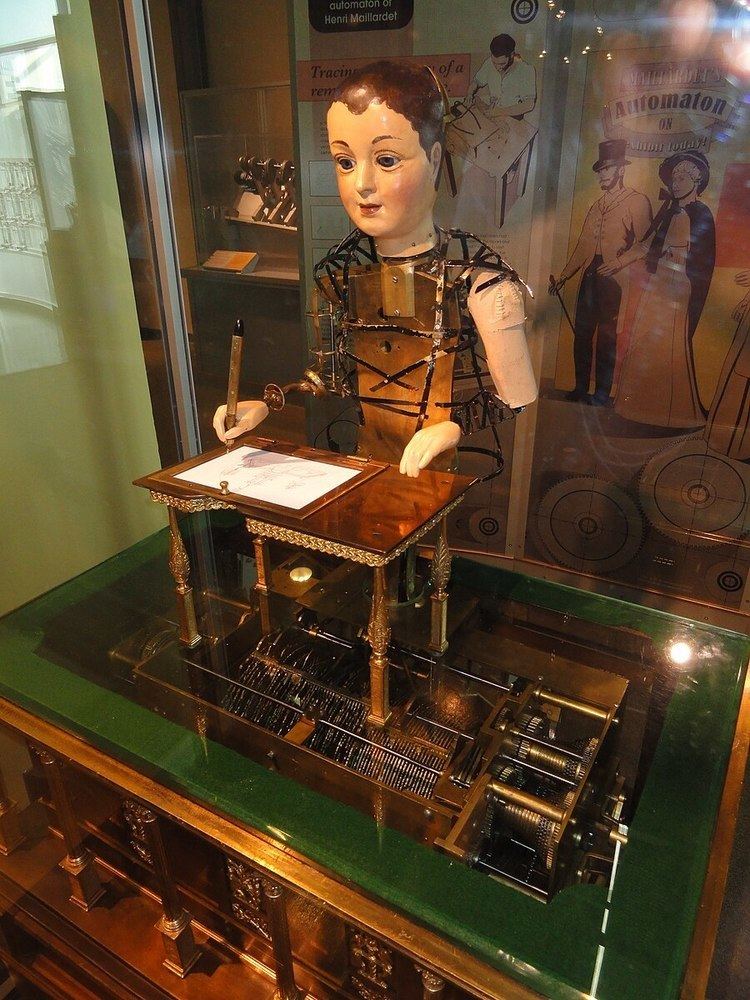 | ||
Maillardet's automaton (or Draughtsman-Writer, sometime also known as Maelzel's Juvenile Artist or Juvenile Artist) is an automaton built in London circa 1800 by a Swiss mechanician, Henri Maillardet. It is currently part of the collections at The Franklin Institute in Philadelphia.
Contents
Acquisition
In November 1928 the Franklin Institute received the pieces of a brass machine. It came from the descendants of John Penn Brock, a family who knew that at some time it had been able to write and draw pictures. Having been in a fire, its restoration involved a considerable amount of work. The Brock family believed that the machine had been made in France by an inventor named Maelzel. The original writing instrument, either a quill or a brush, was replaced with a stylographic fountain pen. Once repaired the automaton began to produce elaborate sketches and poems. In the border surrounding the final poem, the automaton wrote, "Ecrit par L'Automate de Maillardet", translating to "Written by the automaton of Maillardet".
Restorer and paper engineer Andrew Baron spent about 70 hours in 2007 repairing the Maillardet automaton to bring it back to working order,,.
Travel exhibitions
During the early nineteenth century, Maillardet exhibited this automaton and other automata that he created throughout England, other countries in Europe as far as St. Petersburg, Russia. The following is a partial list of known exhibitions of the Maillardet's automaton. The automaton was mostly known as the Juvenile Artist in those exhibitions:
Amazing Machine
The Maillardet's automaton is a highlight of the Amazing Machine permanent exhibit at The Franklin Institute. The exhibition includes more than two dozen rarely displayed machines with exploded views of the machines to show their components such as gears, cams, pulleys and linkages. The Maillardet's automaton is always on display but the staff operate it only a few times a year for public demonstrations. The demonstrations show all seven drawings of the automaton as seen in the followings:
Computer history
The pictures of Maillardet's automaton are among other artifacts in the collections of Computer History Museum in Mountain View, California. The museum has a collection of machines in pre-computer era. Particularly for Maillardet's, the museum highlights the use of its cams in similar function to read-only memory (ROM) of computer to store pre-defined data for retrieval at a later time. In Maillardet's automaton case, it stores motion data necessary to write a poem on paper. It is believed to be the largest cam-based memory of any automaton of the era. The information capacity of the automaton to hold 7 images within the machine was calculated to be 299,040 points, almost 300 kilobits of storage.
Maelzel's Juvenile Artist
The Massachusetts Historical Society holds a drawing created in 1835 by an automaton in the collections of papers and artwork of the Minot family. The drawing is untitled with a depiction of Cupid. The writing on the picture indicated that it was drawn by Maelzel's automaton which was known at the time as the Maelzel's Juvenile Artist. It is believed that at least one member of the Minot family witnessed the drawing by the Juvenile Artist at the exhibition of Johann Nepomuk Maelzel's automata in Boston on April 29, 1835. The Massachusetts Historical Society theorizes that the Juvenile Artist may in fact be the Maillardet's automaton. An explanation is that Maelzel might have acquired the automaton in the 1830s. As in other automata in his collection, they were known at the time as Maelzel's. After Maelzel's death, the automaton could have been auctioned off in Philadelphia to pay his debts. The new owner then attributed it to Maelzel.
